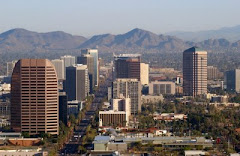 Pace of Decline In Home Prices Sets a Record
Pace of Decline In Home Prices Sets a RecordBy JAMES R. HAGERTY and KELLY EVANS
Wall Street Journal
A closely watched gauge of U.S. home prices shows they are falling sharply across most of the nation, as a deepening slump in the housing market threatens to damp consumer spending.
Home prices in 10 major metropolitan areas in October were down 6.7% from a year earlier, according to the S&P/Case-Shiller home-price indexes, released yesterday by credit-rating firm Standard & Poor’s. That exceeded the previous record year-to-year decline of 6.3% in April 1991, when the economy was emerging from a recession.
New statistics from the Census Bureau, meanwhile, indicate a slowdown in the number of Americans moving to states that led the housing boom, including Nevada, Florida and Arizona.
The silver lining behind the latest home-price data is that they signal the market is making what most economists see as a necessary adjustment, dragging home prices back into closer alignment with Americans’ ability to pay. The market is working its way “back to reality,” says David Seiders, chief economist of the National Association of Home Builders. He thinks house prices will bottom out by early 2009.
Some other economists say that might not happen before 2010. “The housing shock is only about halfway over, and housing prices will continue to fall well into 2009,” says Lehman Brothers economist Michelle Meyer.
During the housing boom in the first half of this decade, fast-rising home prices made it easy for homeowners to take out home-equity loans or refinance their primary mortgages to extract some cash. That helped sustain consumer spending, which accounts for about 70% of U.S. economic activity.
Economists now worry that falling home prices will prompt consumers to pull back on spending enough to slow growth or even tip the economy into recession. “Eventually what’s happening in the housing market is going to catch up with us,” says Patrick Newport, an economist at research-firm Global Insight Inc.
Fears of a sharp drop in consumption were assuaged somewhat last week when the government reported that consumer spending in November grew at the fastest pace in 3½ years. And though holiday sales fell short of retailers’ expectations, consumers, spurred by discounts, spent heavily in the final days before Christmas. Economists say that even if overall spending slows in December, the strength seen in October and November would be enough to keep the economy afloat in the near term.
“The most important determinant of [spending] is always income,” says Harm Bandholz, an economist at UniCredit in New York. He said that Americans’ disposable income has risen a “solid” 2.5% over last year. He and others say that as long as the job market holds up and incomes keep growing, Americans will continue to spend.
The S&P/Case-Shiller index showed that some of the fastest declines in home prices are in metropolitan areas that were among the hottest during the housing boom. Prices were down 12.4% from a year earlier in Miami, 11.1% in San Diego, 10.7% in Las Vegas and 10.6% in Phoenix.
Home prices are still up from a year ago in some cities, such as Seattle and Charlotte, N.C. And people who bought their homes several years ago still are sitting on sizable gains in most of the country.
The boom more than doubled prices in many populous areas near the coasts. The run-up was fueled in part by unusually low interest rates, which slashed the cost of monthly mortgage payments. In addition, in the wake of the technology-stock bubble, many Americans viewed real estate as a safer investment than stocks, and so poured increasing sums into second homes and rental properties. Home sales began to slow in mid-2005. Prices leveled off and then started declining in 2006. Over the past year, mortgage defaults have soared, leading to rapid growth in foreclosures.
Bette Zerba, a Realtor with Re/Max in Phoenix, says local residents trying to sell their homes can’t compete with foreclosed homes selling for $50,000 to $100,000 less than theirs. “The sellers now are having to reduce their prices by 20% to 30% to compete,” she says.
As the market adjusts, single-family housing starts have fallen 55% from their January 2006 peak to a seasonally adjusted annual rate of 829,000. In recent months, lenders and investors have begun owning up to billions of dollars of losses on mortgages and related securities, clearing the decks for an eventual revival in lending.
But the recovery of the housing market is likely to be a gradual process. That’s partly because the boom left prices so far out of whack with incomes. As measured by the S&P/Case-Shiller national index, home prices jumped 74% in the six years through 2006. During the same period, U.S. median household income rose 15%. (Neither figure is adjusted for inflation.) That made housing unaffordable for many Americans.
For a few years, lax lending standards — some loans required no down payments and offered low introductory interest rates — meant borrowers could buy more expensive houses than they could really afford. But lenders have been burned by a surge in defaults that started in 2006, and such mortgages generally are no longer available. That means house prices will have to fall to a level potential buyers can afford.
Mark Zandi, chief economist of Moody’s Economy.com, a research firm in West Chester, Pa., predicts that on average U.S. house prices will decline about 12% by the second quarter of 2009 from their peak in the second quarter of 2006. He expects household income to rise by about the same amount over that period.
Signs of this adjustment are apparent in the latest quarterly analysis of house prices by National City Corp., a Cleveland banking concern, and Global Insight. Economists at the two firms look at home prices in relation to household income and other factors, including population density (an indication of how much land is available) and past differences in prices caused by factors like climate and schools. In the third quarter, they found, prices in 38 of the nation’s 330 metro areas were more than 33% above a level that could be explained by fundamental drivers of housing costs. That was down from 48 metro areas in this “overvalued” category in the second quarter.
“Parts of the housing market are scratching bottom right now,” says Richard DeKaser, chief economist at National City. Sales of new and existing homes are down about 32% from their mid-2005 peak, he says, and probably won’t fall much further before leveling off or starting to recover slowly.
Prices of new homes are likely to start recovering in the first half of 2008 because builders are aggressively chopping prices to clear inventories, says Edward Leamer, an economics professor at the University of California, Los Angeles. Recent price cuts by builders may have reduced demand in the short term because they encourage potential buyers to expect further discounts.
But prices of previously occupied homes are likely to continue falling slowly for several years, Prof. Leamer says. That’s because people trying to sell their homes often don’t have an urgent need to move, and try to hold out for a price they consider fair.
On average, prices of previously occupied homes, as measured by the S&P/Case-Shiller indexes, are likely to drop another 7% in 2008 before flattening out in 2009, says Thomas Lawler, a housing economist in Vienna, Va.
Inventories of unsold homes remain very high and may increase in the new year as lenders dump more foreclosed houses on the market. The number of detached single-family homes listed for sale in October was enough to last 10½ months at the current sales rate, according to the National Association of Realtors. That was more than double the level of two years ago and the highest since 1985.
Along with inventories, the nation’s home ownership rate will have to adjust to today’s realities as many Americans who stretched too far to buy homes in recent years go back to renting. The home ownership rate in the third quarter stood at 68.2% of households, down from a peak of 69.2% in 2004. Even a small drop in that rate has a big effect on housing demand. Economists at Goldman Sachs have warned that falling home ownership rates may force a further 40% drop in housing starts next year, to an annual rate as low as 500,000 units, before construction starts to recover.
The mortgage market also needs to adjust further. Most of the funding for home loans comes from investors who buy securities backed by bundles of mortgages. Since August, many of those investors have shunned the market amid fears of rising defaults. As a result, lenders generally are focusing on loans that can be sold to government-sponsored investors Fannie Mae or Freddie Mac, or insured by the Federal Housing Administration. So-called jumbo loans — those above $417,000, too big to be sold to Fannie or Freddie — have grown much more expensive, deterring buyers in high-cost areas.
The current scarcity of funds available for mortgage lending creates a chicken-and-egg situation, says Prof. Leamer. Investors who provide funding for home loans don’t want to commit more money until they believe the housing market is getting better. But it’s hard for the housing market to rebound as long as mortgage credit is tight. Lower prices eventually will break this impasse, by luring buyers back into the market and reassuring investors that the market is finding a bottom, he says.









